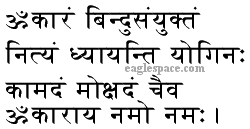Om Mantra Sources, Meaning, Significance, Origin
OM or OMkaaram Mantra in Sanskrit
OMkaaraM bindusaMyuktaM
nityaM dhyaayanti yoginaH
kaamadaM mokshadaM chaiva
AUMkaaraaya namo namaH
Summary of the OMkaaram Mantra
Aum, let us meditate on the one Brahman who can unite all energies of the universe (saMyuktaM) into a single point or dot (bindu).
Let us meditate (dhyaayanti) daily (nityam) on that Brahman who will lead us on the path to becoming yogis (yoginaH). Let us meditate on that Brahman who will grant us liberation from our karma (kaamadaM) and moksha or eternal freedom (mokshadaM). Let us bow again and again (namo namaH) to that Brahman (AUMkaaraaya) – the supreme Lord.
![]()

Chanting and Significance of the OMkaaram Mantra
The omkaaram is chanted to acknowledge one of the most powerful principles of hinduism – which is OM. The Upanisads (one of the sacred texts of vedic thought) say that the word OM represents the inter-breath, i.e. the gap between the in-breath and the out-breath. The Gods hid the letter OM in this gap so that their enemies would not think of looking for it in that location! Since OM is considered the primary (pranava) seed (beej) mantra, i.e. the mantra from which all other mantras originate, it was important to safeguard its existence.
Brahman, the universal concept of God that pervades all elements (living and non-living), is said to originate with the word OM. Brahman can be viewed as a single point of existence or alternately, as the source of universal consciousness. This mantra suggests that OM and Brahman are one and the same entity (bindu-saMyuktaM)!
कामदं मोक्षदं चैव, ॐकाराय नमो नम: ।
ॐ शान्ति, शान्ति, शान्ति ।।

